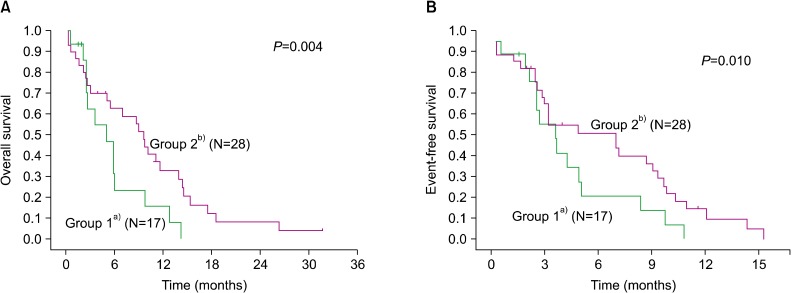Blood Res.
2013 Mar;48(1):24-30. 10.5045/br.2013.48.1.24.
Karyotypic change between diagnosis and relapse as a predictor of salvage therapy outcome in AML patients
- Affiliations
-
- 1Department of Internal Medicine, Yonsei University College of Medicine, Seoul, Korea. minbrmmd@yuhs.ac
- KMID: 2270722
- DOI: http://doi.org/10.5045/br.2013.48.1.24
Abstract
- BACKGROUND
Only a few patients who experience AML relapse derive lasting benefit from re-induction therapy. The utility of reassessing the disease karyotype at relapse is unclear. The main goals of this study were to identify prognostic factors for AML relapse and to determine the prognostic utility of karyotypic change between diagnosis and relapse as a variable for predicting response to salvage therapy for relapsed AML.
METHODS
This retrospective study included 58 patients with relapsed AML treated at the Yonsei University College of Medicine between 2005 and 2010. Karyotypes at both diagnosis and relapse were available for 45 patients (77%). A change in karyotype at relapse was observed in 17 of 45 cases (37%), and no change was noted in 28 of 45 cases (62%).
RESULTS
Karyotypic changes between diagnosis and relapse were associated with the response rate (RR) to salvage therapy (P=0.016). Overall survival (OS) and event-free survival (EFS) in the group with karyotypic changes between diagnosis and relapse were significantly different from those with no karyotypic changes (P=0.004 and P=0.010, respectively). We applied multiple multivariate Cox regression analyses to identify independent prognostic factors for overall response (OR), OS, and EFS. A change in karyotype between diagnosis and relapse was significantly associated with OS (P=0.023; RR=2.655) and EFS (P=0.033; RR=2.831).
CONCLUSION
Karyotypic changes between the diagnosis and relapse of AML could be used to predict outcomes and tailor clinical and biological therapeutic strategies for relapsed AML patients.
Keyword
MeSH Terms
Figure
Cited by 1 articles
-
Evaluation of prognostic factors in patients with relapsed AML: Clonal evolution versus residual disease
Hyojeong Kim, Young Mi Seol, Moo-Kon Song, Young Jin Choi, Ho-Jin Shin, Sang Hyuk Park, Eun Yup Lee, Joo-Seop Chung
Blood Res. 2016;51(3):175-180. doi: 10.5045/br.2016.51.3.175.
Reference
-
1. Dohner H, Estey EH, Amadori S, et al. Diagnosis and management of acute myeloid leukemia in adults: recommendations from an international expert panel, on behalf of the European LeukemiaNet. Blood. 2010; 115:453–474. PMID: 19880497.2. Craddock C, Tauro S, Moss P, Grimwade D. Biology and management of relapsed acute myeloid leukaemia. Br J Haematol. 2005; 129:18–34. PMID: 15801952.
Article3. Weltermann A, Fonatsch C, Haas OA, et al. Impact of cytogenetics on the prognosis of adults with de novo AML in first relapse. Leukemia. 2004; 18:293–302. PMID: 14671635.
Article4. Kawamata N, Ogawa S, Seeger K, et al. Molecular allelokaryotyping of relapsed pediatric acute lymphoblastic leukemia. Int J Oncol. 2009; 34:1603–1612. PMID: 19424578.
Article5. Kern W, Haferlach T, Schnittger S, Ludwig WD, Hiddemann W, Schoch C. Karyotype instability between diagnosis and relapse in 117 patients with acute myeloid leukemia: implications for resistance against therapy. Leukemia. 2002; 16:2084–2091. PMID: 12357361.
Article6. Bennett JM, Catovsky D, Daniel MT, et al. Proposed revised criteria for the classification of acute myeloid leukemia. A report of the French-American-British Cooperative Group. Ann Intern Med. 1985; 103:620–625. PMID: 3862359.7. Mitelman F, editor. ISCN: Guidelines for cancer cytogenetics. Supplement to an international system for human cytogenetic nomenclature. 1991. Basel, Switzerland: Karger;p. 1–53.8. Grimwade D, Walker H, Oliver F, et al. The Medical Research Council Adult and Children's Leukaemia Working Parties. The importance of diagnostic cytogenetics on outcome in AML: analysis of 1,612 patients entered into the MRC AML 10 trial. Blood. 1998; 92:2322–2333. PMID: 9746770.
Article9. Yates J, Glidewell O, Wiernik P, et al. Cytosine arabinoside with daunorubicin or adriamycin for therapy of acute myelocytic leukemia: a CALGB study. Blood. 1982; 60:454–462. PMID: 6953986.
Article10. Chucrallah AE, Stass SA, Huh YO, Albitar M, Kantarjian HM. Adult acute lymphoblastic leukemia at relapse. Cytogenetic, immunophenotypic, and molecular changes. Cancer. 1995; 76:985–991. PMID: 8625224.
Article11. Vora AJ, Potter AM, Anderson LM, Lilleyman JS. Frequency and importance of change in blast cell karyotype in relapsing childhood lymphoblastic leukemia. Pediatr Hematol Oncol. 1994; 11:379–386. PMID: 7947010.
Article12. Estey E, Keating MJ, Pierce S, Stass S. Change in karyotype between diagnosis and first relapse in acute myelogenous leukemia. Leukemia. 1995; 9:972–976. PMID: 7596187.13. Schmidt-Hieber M, Blau IW, Richter G, et al. Cytogenetic studies in acute leukemia patients relapsing after allogeneic stem cell transplantation. Cancer Genet Cytogenet. 2010; 198:135–143. PMID: 20362228.
Article14. Schiffer CA, Lee EJ, Tomiyasu T, Wiernik PH, Testa JR. Prognostic impact of cytogenetic abnormalities in patients with de novo acute nonlymphocytic leukemia. Blood. 1989; 73:263–270. PMID: 2910364.
Article15. Keating MJ, Smith TL, Kantarjian H, et al. Cytogenetic pattern in acute myelogenous leukemia: a major reproducible determinant of outcome. Leukemia. 1988; 2:403–412. PMID: 3164797.
- Full Text Links
- Actions
-
Cited
- CITED
-
- Close
- Share
- Similar articles
-
- Evaluation of prognostic factors in patients with relapsed AML: Clonal evolution versus residual disease
- Outcome of Intensive Therapy for Children with Relapsed Acute Myeloid Leukemia: A Single Institution Korean Study
- Treatment outcome and prognostic factors in relapsed pediatric acute myeloid leukemia
- Lineage Switch at Relapse of Childhood Acute Leukemia: A Report of Four Cases
- Significance of trilineage myelodysplasia in de novo acute myeloid leukemia


